The Gum Nebula is a large emission nebula located approximately 1,470 light-years away. It occupies 36 degrees of the apparent sky in the direction of the constellations Puppis and Vela. It contains the 11,000-year-old Vela Supernova Remnant and the Vela Pulsar. The nebula is catalogued as Gum 12 in the Gum catalog of emission nebulae.
The Gum Nebula is one of the largest structures in angular size in the sky. With an apparent size of 36 degrees, it covers an area equivalent to 72 full Moons. The nebula appears considerably larger than the Large Magellanic Cloud (LMC), which occupies 10 degrees of the southern sky. However, unlike the LMC, which is easily visible to the unaided eye on a clear night, the Gum Nebula is exceptionally faint. It was not discovered until the 1950s.
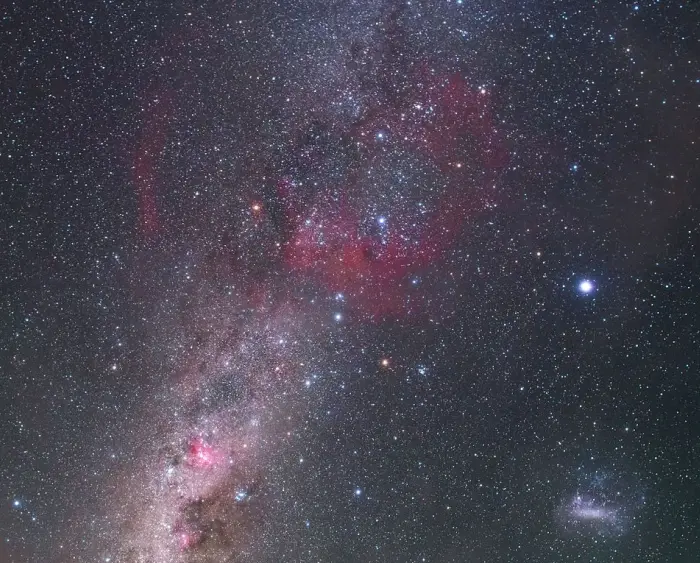
The Gum Nebula visible at the background of the Milky Way galaxy, with the Large Magellanic Cloud in the bottom right for scale. The brightest star in this view is Canopus. Image (cropped): P. Horálek/ESO (CC BY 4.0)
The nebula is believed to be about 1,000 light-years across. Its nearest edge lies approximately 450 light-years away and the farthest edge is around 1,500 light-years away.
The vast cloud of dust and gas was previously believed to be an expanding remnant of a supernova event that occurred about a million years ago. However, more recent studies support the belief that it is an evolved H II region, a site that was once a giant molecular cloud that was eroded away by supernovae and the stars that formed within it.
The Gum Nebula is home to the Vela Supernova Remnant, one of the closest supernova remnants to the Sun. The Vela SNR is the remains of a Type II supernova that occurred around 11,000 years ago. It has an apparent magnitude of 12 and an apparent size of about 8 degrees.
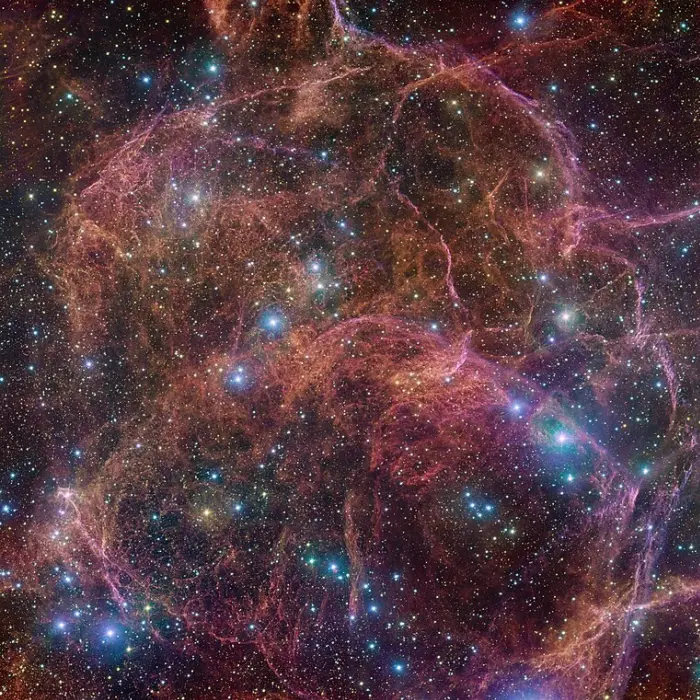
The Vela supernova remnant imaged by the VLT Survey Telescope. The image shows stringy clouds of hot pink and golden orange, nested together all over the frame, almost like the messy fragments of a spider’s web. Close to these colourful clouds, we find bright blue massive stars. In between the clouds there are gaps, revealing stars in blue and yellow, almost like sparklers. This image shows a spectacular view of the orange and pink clouds that make up what remains after the dramatic end of a massive star — the Vela supernova remnant. This detailed image consists of 554 million pixels, and is a combined mosaic image of observations taken with the 268-million-pixel OmegaCAM camera at the VLT Survey Telescope, hosted at ESO’s Paranal Observatory. Image credit: ESO/VPHAS+ team. Acknowledgement: Cambridge Astronomical Survey Unit (CC BY 4.0)
The Vela Supernova Remnant is associated with the Vela Pulsar, the brightest pulsar in the sky at radio frequencies. When astronomers linked the pulsar with the Vela SNR in 1968, this was the first direct evidence that supernovae form neutron stars.
The Vela SNR contains the Pencil Nebula (NGC 2736), a narrow nebula that is believed to have formed from the shock wave of the Vela SNR. The Pencil Nebula has an apparent size of 30 by 7 arcminutes and an apparent magnitude of 12.0. It has a radius of about 5 light-years.
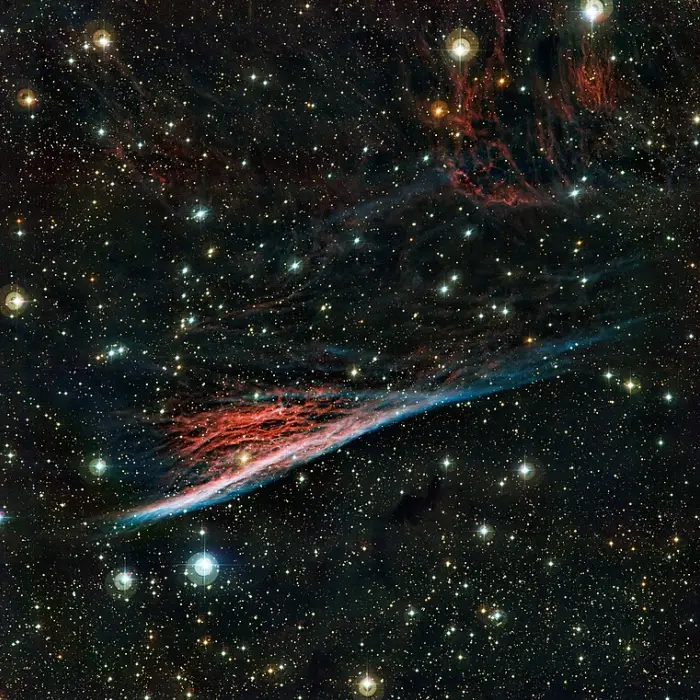
The oddly shaped Pencil Nebula (NGC 2736) is pictured in this image from ESO’s La Silla Observatory in Chile. This nebula is a small part of a huge remnant left over after a supernova event that took place about 11,000 years ago. The image was produced by the Wide Field Imager on the MPG/ESO 2.2-metre telescope at ESO’s La Silla Observatory in Chile. Image credit: ESO (CC BY 3.0)
The Vela SNR overlaps Puppis A, the remnant of a supernova event that occurred 3,700 years ago. Even though the two overlap in the sky, they not physically related. Puppis A lies four times farther away. It has an angular size of about 1 degree.
The Gum Nebula harbours around 32 cometary globules. These are Bok globules with comet-like shapes. They have been stripped of material by the intense ultraviolet light from the luminous nearby stars and, as a result, they have tails.
Bok globules are relatively small patches of dark nebulosity composed of dense dust and gas where new stars may form. The small, dark nebulae typically produce double and multiple star systems.
The cometary globules in the Gum Nebula are eroded away by the strong radiation from the bright blue stars Regor (Gamma2 Velorum) and Naos (Zeta Puppis). These massive, hot O-type stars are among the most luminous stars visible to the unaided eye. The Gamma2 Velorum system is composed of an O-type giant and a Wolf-Rayet star, while Zeta Puppis is an O-type supergiant with 56.1 times the Sun’s mass and 813,000 times its luminosity. Another star responsible for evaporating away the Bok globules was the progenitor of the Vela Supernova Remnant.
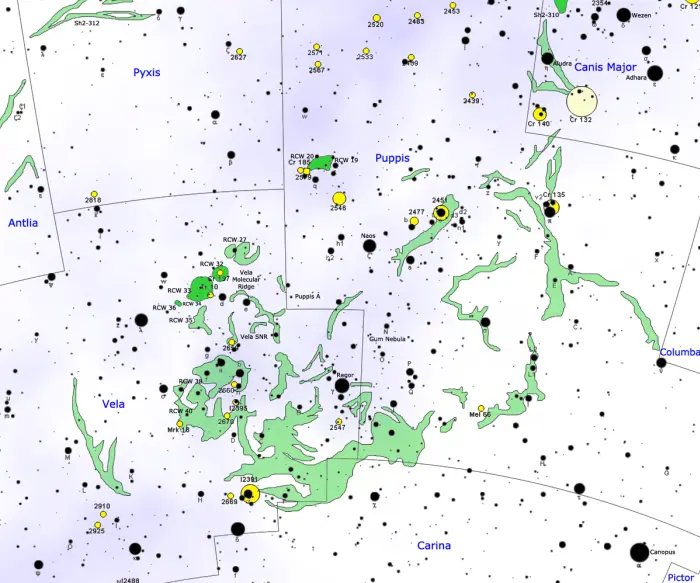
Map of the Gum Nebula, credit: Roberto Mura (CC BY-SA 3.0)
One of the nebula’s cometary globules hosts the Herbig-Haro object HH 46/47, which was imaged by the James Webb Space Telescope (JWST) in 2023. Herbig-Haro objects are small, bright patches of nebulosity that form when very young stars eject some of the accreting material along their axes of rotation. The material forms two jets of plasma, partially ionized gas, that collide with the interstellar medium and form small patches of emission nebulosity which comprise Herbig-Haro objects.
HH 46/47 is one of the most studied Herbig-Haro objects in the sky. It was discovered by American astronomer R. D. Schwartz in 1977. The whole complex is about 10 light-years across. It includes four emission nebulae – HH 46, HH 47A, HH 47C, and HH 47D – and a jet, HH 47B. HH 47B was the first jet to be associated with very young stars.
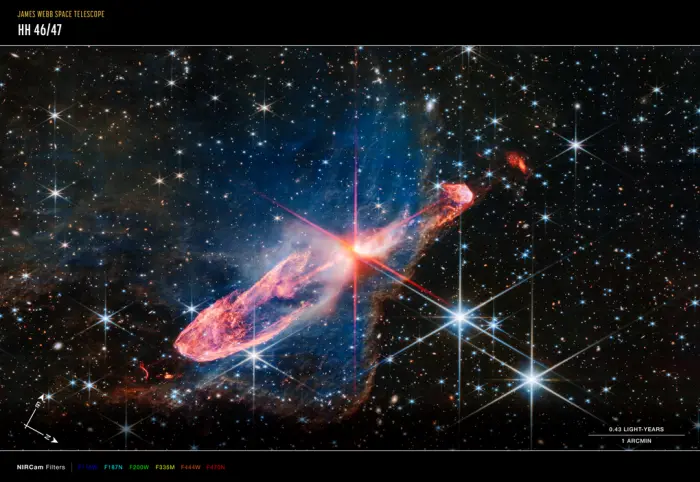
The NASA/ESA/CSA James Webb Space Telescope has captured a high-resolution image of a tightly bound pair of actively forming stars, known as Herbig-Haro 46/47, in near-infrared light. Look for them at the centre of the red diffraction spikes. The stars are buried deeply, appearing as an orange-white splotch. They are surrounded by a disc of gas and dust that continues to add to their mass. Herbig-Haro 46/47 is an important object to study because it is relatively young — only a few thousand years old. Stars take millions of years to form. Targets like this also give researchers insight into how stars gather mass over time, potentially allowing them to model how our own Sun, a low-mass star, formed. The two-sided orange lobes were created by earlier ejections from these stars. The stars’ more recent ejections appear as blue, thread-like features, running along the angled diffraction spike that covers the orange lobes. Actively forming stars ingest the gas and dust that immediately surrounds them in a disc (imagine an edge-on circle encasing them). When the stars ‘eat’ too much material in too short a time, they respond by sending out two-sided jets along the opposite axis, settling down the star’s spin, and removing mass from the area. Over millennia, these ejections regulate how much mass the stars retain. Image credit: NASA, ESA, CSA, J. DePasquale (STScI) (CC BY 4.0)
Facts
The Gum Nebula was named after the Australian astronomer Colin Stanley Gum, who discovered it in 1952. Gum discovered the nebula using the 130-foot nebula spectrograph at the Commonwealth Observatory (now Mount Stromblo Observatory) near Canberra, Australia.
Gum published his discoveries in the Gum catalog, an astronomical catalogue of 84 emission nebulae in the southern celestial hemisphere. The Gum catalog was published in a 1955 paper entitled “A study of diffuse southern H-alpha nebulae.” The Gum Nebula is catalogued as the 12th object in the catalogue (Gum 12).
Gum reported the discovery of the nebula in the journal The Observatory in August 1952. He was the first to suggest that the nebula is ionized by the luminous Regor and possibly also by Naos.
The Gum Nebula was photographed using high-speed Kodak film during the Apollo 16 mission (April 16 – 27, 1972).
Location
The Gum Nebula lies in the southern celestial hemisphere, in the constellations Puppis and Vela. It covers 36° of the sky between the triangle formed by the Canis Major stars Aludra, Adhara, and Wezen and the False Cross, formed by Avior and Aspidiske in Carina with Alsephina and Markeb in Vela. The central region of the nebula lies between Naos in Puppis and Regor in Vela.
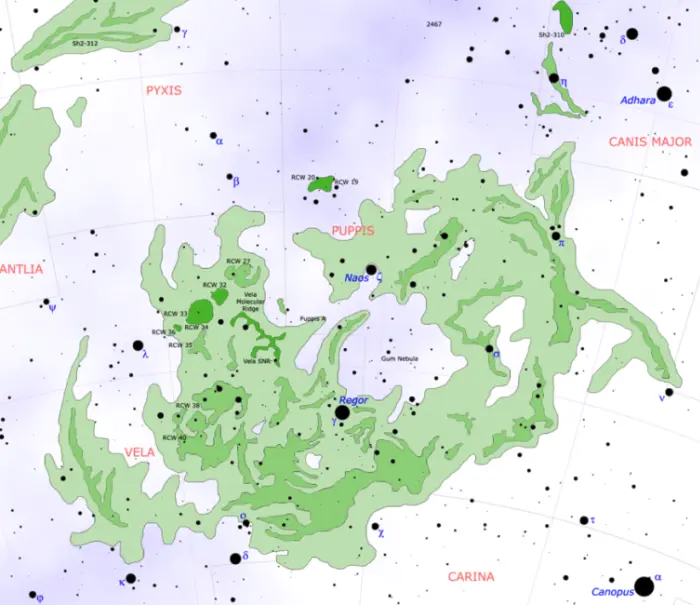
The location of the Gum Nebula, credit: Roberto Mura (CC BY-SA 4.0)
The nebula is exceptionally faint in optical wavelengths and best seen in the infrared band.
Gum Nebula – Gum 12
| Constellation | Vela, Puppis |
| Object type | H II region |
| Right ascension | 07h 43m 00s |
| Declination | −42° 06′ 00′′ |
| Apparent magnitude | +12 (infrared) |
| Apparent size | 30 degrees |
| Absolute magnitude | 3.73 (infrared) |
| Distance | 1,470 light-years (450 parsecs) |
| Names and designations | Gum Nebula, Gum 12 |
Images
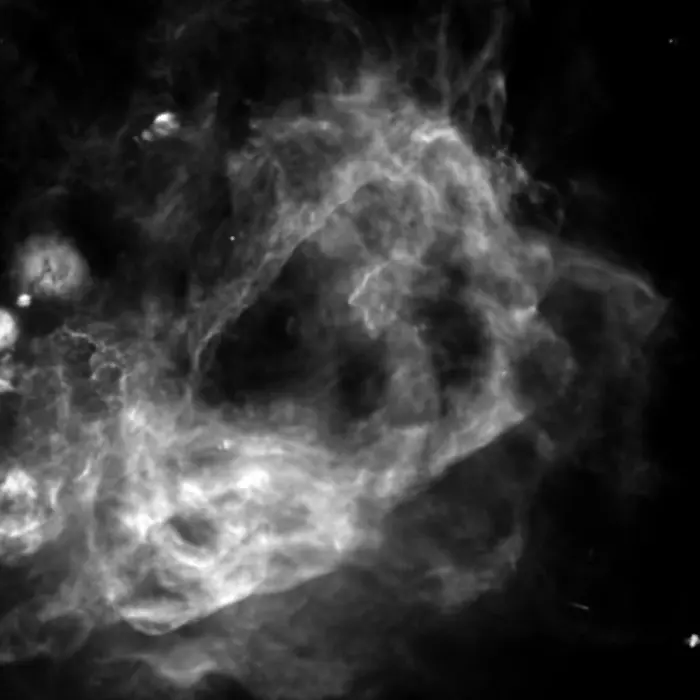
H-alpha map of the Gum Nebula, image credit: Douglas P. Finkbeiner, Meli thev (CC BY-SA 4.0)
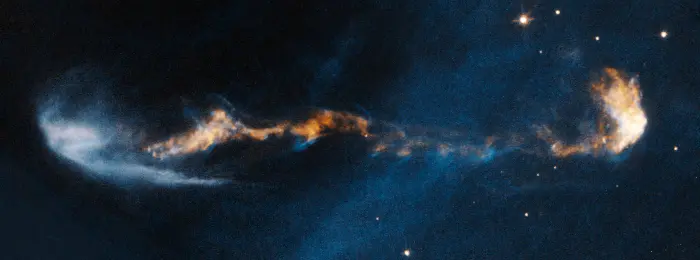
HH 46/47 – a pair of jets escaping a protostar, captured by the Hubble Space Telescope (HST), image credit: NASA, ESA, and P. Hartigan (Rice University)
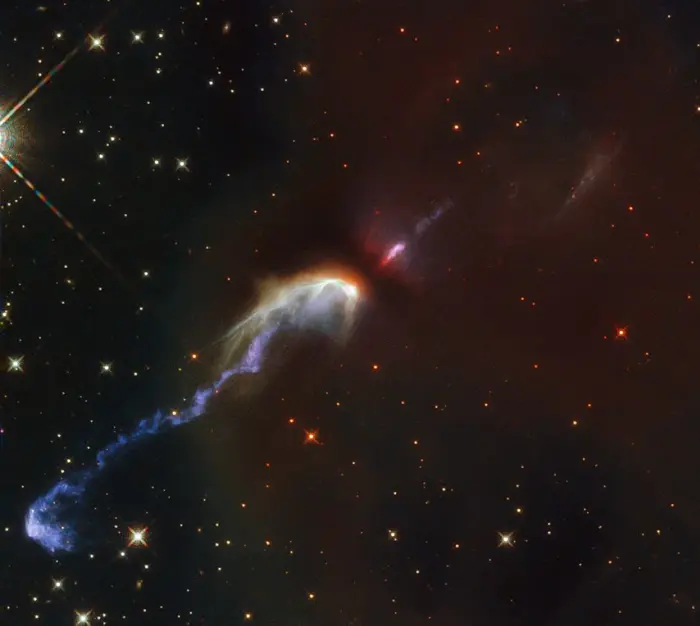
Herbig-Haro objects are some of the rarer sights in the night sky, taking the form of thin spindly jets of matter floating amongst the surrounding gas and stars. The two Herbig-Haro objects catalogued as HH46 and HH47, seen in this image taken with the NASA/ESA Hubble Space Telescope, were spotted in the constellation of Vela (The Sails), at a distance of over 1400 light-years from Earth. Prior to its discovery in 1977 by the American astronomer R. D. Schwartz, the exact mechanism by which these multi-coloured objects formed was unknown. Before 1997 it was theorised by Schwartz and others that the objects could be a type of reflection nebula, or a type of shock wave formed from the gas emitted from a star interacting with the surrounding matter. The mystery was finally solved when a protostar, unseen in this image, was discovered at the centre of the long jets of matter. The outflows of matter, some 10 light-years across, were ejected from the newly born star and violently propelled outwards at speeds of over 150 kilometres per second. Upon reaching the surrounding gas, the collision created the bright shock waves seen here. Image credit: ESA/Hubble & NASA, B. Nisini (CC BY 4.0)